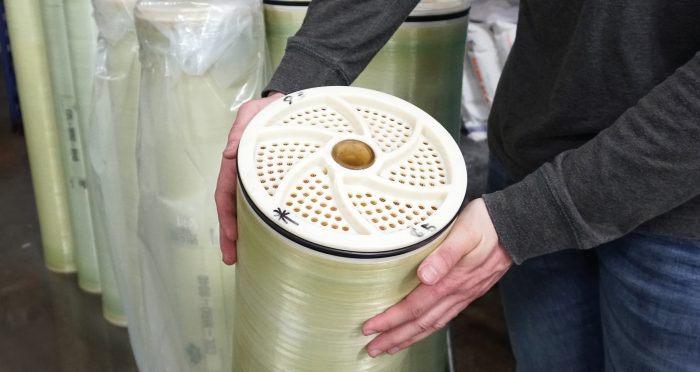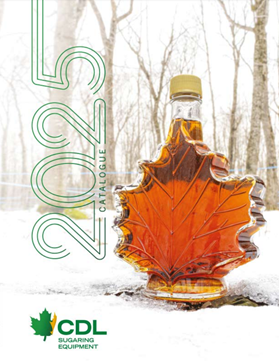Take Good Care of your Membranes and they’ll Serve you Well!
Mastering the essentials: washing, maintenance, and storage
If you have any type of reverse osmosis system, you already know how much valuable time it saves you. That is, as long as you maintain the membranes in order to maximize their performance. This means completing three essential steps each season: washing your membranes at the beginning of the season, washing them throughout the season, and storing them once the season ends. It’s easier than you think to master these steps, and the result, well-maintained membranes that are worth the effort you put into them.
Why we recommend CDL membranes
The membrane is the heart of the reverse osmosis system and is by far its most delicate component. Consequently, taking care of the membranes is essential to your sugarbush’s performance. Why not take advantage of advanced CDL membrane technology to minimize the risks of clogging and premature wear and to maximize the system’s performance? They provide superior circulation and their LF membrane filter reduces fouling. At the same time, CDL membranes allow for superior retention of mineral salts to ensure that the finished product maintains maple syrup’s nutrient profile. What’s more, their outstanding manufacturing quality means that they are robust and more resistant to washing. That quality is all the more important since their performance is influenced by a dozen different factors. These factors were taken into account as CDL’s membranes were developed. Finally, CDL offers three different diameters (4, 8, and 16 inches) to fit all types of reverse osmosis systems.

Start-of-season washing method
When membranes clog in the first few days of the season, it can be quite frustrating because they lose their ability to let the permeate pass through very quickly. In an hour or less, you can see the permeability of the last membrane drop to almost zero. Why is this? The first sap contains varying concentrations of a substance that has collected in the maple tree throughout the winter. This plant cytoplasm is very rich in proteins, mineral salts, and dissolved organic matter; concentration causes it to collect quickly on the surface of the membrane, causing clogging. Here are some tips to help you avoid or limit inconveniences when running your RO systems:
- Reduce the concentration to 10 Brix.
- Keep a close eye on the performance of the membranes, especially the last one.
- Don’t allow the system to concentrate for too long, because it’s harder to restore the original performance after severe clogging.
- Alternate citric acid with alkaline washes, rinses, and acid treatment.
- Run performance tests (PWP) to make sure the washes are working; repeat as needed.
When to wash the membranes: the 15% rule
- A 15% loss in performance during the concentration process should be corrected with an alkaline wash and, if necessary, an acid wash;
- Citric acid is an excellent preservative against bacterial growth. It should be used on a regular basis;
- Membranes can be soaked in this acid for several days without damaging the equipment or the membranes;
- During the season, it can be used when the system isn’t running;
- Wash the membranes at least once a day;
- Never let the membranes rest in the concentrate.
- After shutting down the system, de-sugar it and rinse it briefly with permeate.
What type of water should you use?
Ideally, you should always use permeate. If this is difficult or impossible, you can use soft water that is low in mineral salts and very low in iron and manganese. Surface wells generally contain very little iron and manganese. However, you have to be very careful with the bacterial load of the water. Chlorinated water should also be avoided unless it is de-chlorinated by pumping at least 24 hours in advance.
Maintenance: wash daily with soap
Perform a 15–20 minute rinse at 50% membrane capacity, followed by a 30-minute soap wash at 30 degrees Celsius and a 30-minute rinse at 50% membrane capacity. The alkaline wash should be repeated if the solution becomes cloudy. The solution of the final wash must be clear. If necessary, you can perform an acid wash after completing the first step; to do so, add the acid wash, then rinse at 50% membrane capacity, followed by a soap wash and a final rinse at 50% membrane capacity. If sterilization is necessary, add it after the first two steps. The last step is sterilization with Oxysan, followed by a rinse at 50% membrane capacity.
At the end of season
It’s important to carefully follow our storage recommendations:
- Store the membranes in a cool, frost-free place.
- Prepare a solution, ideally with permeate or with fresh water that is low in mineral salts, iron, and manganese.
- Mix 1% sodium metabisulfite (by weight) with the permeate (½ lb/5 gallons SMBS).
- Mix well and pour into the membranes’ storage canisters.
- For longer-term storage, replace one gallon of water with the same amount of food-grade glycerin or propylene glycol with the same proportion of sodium metabisulfite. This mixture does not protect against freezing.
- For freeze protection during storage, make a 50/50 mixture of Water and glycerin or propylene glycol, add metabisulfite, and mix well. The 50% propylene glycol blend is available at your local CDL dealer in 20 litre tubs.


